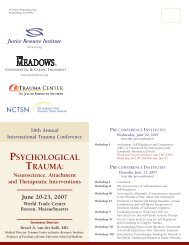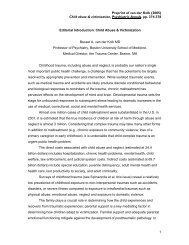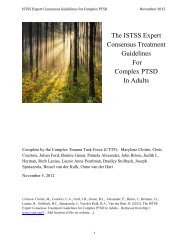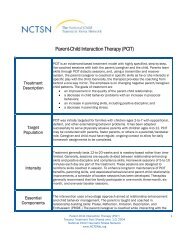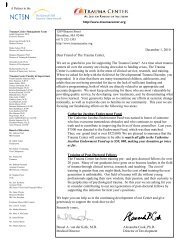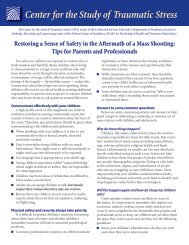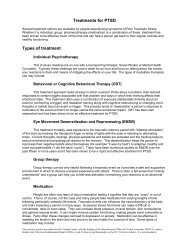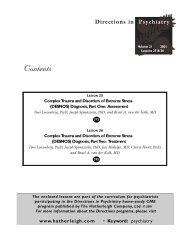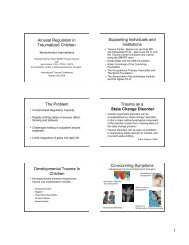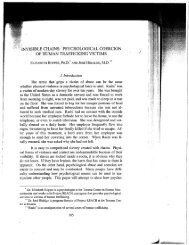10 CW360 o <strong>Trauma</strong>-Informed <strong>Child</strong> <strong>Welfare</strong> Practice • W<strong>in</strong>ter 2013Overview<strong>The</strong> Impact of <strong>Trauma</strong>tic Stress on Parents Involved<strong>in</strong> the <strong>Child</strong> <strong>Welfare</strong> SystemErika Tullberg, MPH, MPAThomas is a new caseworker supervis<strong>in</strong>g avisit between his client, Denise, age 25, andher three children, Christopher, Jr., age 5,Tanya, age 3, and Damon, age 2. This visithas already been rescheduled twice – it wassupposed to happen after the agency’s weeklydomestic violence group, which Denise ismandated to attend as part of her service plan,but she keeps miss<strong>in</strong>g the meet<strong>in</strong>gs. Thomaswants to talk to Denise about how she needsto come to these groups if she wants her kidsback, but he has seen her temper and doesn’twant to do anyth<strong>in</strong>g to make today’s visit gobadly so decides to let it go.Damon has not said anyth<strong>in</strong>g s<strong>in</strong>cearriv<strong>in</strong>g at the agency; he is still strapped<strong>in</strong>to his stroller and s<strong>in</strong>ce com<strong>in</strong>g <strong>in</strong>tothe visitation room has been wh<strong>in</strong><strong>in</strong>g andreach<strong>in</strong>g up to Denise, but she keeps tell<strong>in</strong>ghim to “behave” while she tries to get hissibl<strong>in</strong>gs to settle down. After a few m<strong>in</strong>utesof runn<strong>in</strong>g around Christopher trips on hisshoelaces and starts bleed<strong>in</strong>g from his head –Tanya shrieks when she sees the blood, andDenise yells at Christopher say<strong>in</strong>g that he’sru<strong>in</strong>ed the visit and is always out of control,just like his father. Thomas goes to comfortTanya, who has started to shake and cryuncontrollably, but Denise steps <strong>in</strong> front ofhim say<strong>in</strong>g that she can handle her kids andthat they don’t need his help.<strong>The</strong> child welfare system has become<strong>in</strong>creas<strong>in</strong>gly attuned both to the traumathat children and youth <strong>in</strong> the systemhave experienced and to the importance ofaddress<strong>in</strong>g such trauma as part of ensur<strong>in</strong>gtheir safety, permanence and well-be<strong>in</strong>g(Kisiel, Fehrenbach, Small, & Lyons, 2009).Research on the impact of trauma on fostercare placement stability <strong>in</strong> the short term,and long-term health outcomes over thelifespan, has helped to spur <strong>in</strong>creased tra<strong>in</strong><strong>in</strong>gon trauma for staff, resource parents, andother system stakeholders and availability ofevidence-based <strong>in</strong>terventions for children andyouth (Landsverk, Garland, Reutz, & Davis,2011).However, we know that for children <strong>in</strong> thechild welfare system, the trauma they haveexperienced has often happened at home:abuse or neglect from a caretaker, exposureto domestic violence, or separation from aparent due to homelessness, <strong>in</strong>carceration orother family stressors. For parents who grewup under similar circumstances, or who haveexperienced traumatic events <strong>in</strong> adulthood, itmay be difficult to provide their own childrenwith support and structure if their owntrauma rema<strong>in</strong>s unaddressed. Research hasdemonstrated, <strong>in</strong> fact, that a parent’s traumahistory may <strong>in</strong>crease his or her children’srisk of maltreatment (Banyard, Williams, &Siegel, 2003; Cohen, Hien, & Batchelder,2008), and that the parent’s trauma-relatedsymptoms and ability to respond <strong>in</strong> aprotective manner to his or her children isa predictor of a child develop<strong>in</strong>g traumasymptoms follow<strong>in</strong>g exposure to a traumaticevent (Chemtob, Nomura, & Abramovitz,2008). If parents do not feel safe, they will beless able to keep their children safe.Anecdotal evidence and grow<strong>in</strong>g researchsuggests that trauma is very common amongparents receiv<strong>in</strong>g child welfare services. InNew York City, the ACS-NYU <strong>Child</strong>ren<strong>Trauma</strong> Institute’s Safe Mothers, Safe<strong>Child</strong>ren program is address<strong>in</strong>g traumaexperienced by mothers receiv<strong>in</strong>g child welfarepreventive services. Dur<strong>in</strong>g project plann<strong>in</strong>g<strong>in</strong>terviews conducted <strong>in</strong> 2008, East Harlempreventive service program directors reportedconcerns about trauma experienced by theirclients, cit<strong>in</strong>g related problems with theirability to have patience with, empathy for,and express affection towards their children.Dur<strong>in</strong>g subsequent screen<strong>in</strong>gs with mothersreceiv<strong>in</strong>g services from a subset of theseagencies, 92 percent reported at least oneprior traumatic experience with the averagebe<strong>in</strong>g 2.6 categories of traumatic events. Fiftyfourpercent of mothers met probable criteriafor post-traumatic stress disorder, 62 percentmet probable criteria for depression, and 49percent met probable criteria for both PTSDand depression (Chemtob, Griff<strong>in</strong>g, Tullberg,Roberts, & Ellis, 2011).Research has shown that parents withhistories of trauma can be harder to engage<strong>in</strong> services and have difficulty trust<strong>in</strong>g serviceproviders (Kemp, Marcenko, Hoagwood,& Vesneski, 2009; Dawson & Berry,2002). Despite this and the prevalence oftrauma among parents <strong>in</strong> the child welfaresystem, our experience is that it is relativelyFor parents who grew up under similar circumstances, or who haveexperienced traumatic events <strong>in</strong> adulthood, it may be difficult to providetheir own children with support and structure if their own traumarema<strong>in</strong>s unaddressed.uncommon for parents to receive traumaspecificscreen<strong>in</strong>g, much less trauma-<strong>in</strong>formedmental health services – and many childwelfare staff are not tra<strong>in</strong>ed to recognizetrauma symptoms and how trauma canimpact parent<strong>in</strong>g and child safety. As a result,child welfare staff may be more likely toregard parents like Denise as non-compliant,disengaged, detached from their children,angry and defensive.How else could Thomas understandDenise, the decisions she’s mak<strong>in</strong>g, and howshe responds to her children? How can he usethat knowledge to help her? With the benefitof a “trauma lens,” the above scenario couldbe reframed as follows:• Ask questions. Caseworkers are oftenworried that ask<strong>in</strong>g clients detailedquestions about their past traumaticexperiences may cause their clients to
CW360 o <strong>Trauma</strong>-Informed <strong>Child</strong> <strong>Welfare</strong> Practice • W<strong>in</strong>ter 2013 11become anxious or distraught, but afterbe<strong>in</strong>g tra<strong>in</strong>ed to conduct trauma screen<strong>in</strong>gsby Safe Mothers, Safe <strong>Child</strong>ren projectcl<strong>in</strong>icians, caseworkers said they learnedhelpful <strong>in</strong>formation while report<strong>in</strong>g lowlevels of distress for themselves and theirclients (Dawson & Berry, 2002). Ask<strong>in</strong>gmay also help ease the shame associatedwith clients’ past experiences and result <strong>in</strong>their feel<strong>in</strong>g more supported and less alone.• Anticipate trauma triggers. <strong>The</strong> domesticviolence between Denise and her children’sfather was likely a traumatic experiencefor both her and her children, and thefact that she is not attend<strong>in</strong>g domesticviolence groups may be due to avoidance,a common trauma symptom. Denisemay be more likely to attend visits withher children if they were scheduled at adifferent time than these groups. Likewise,if Thomas approached Denise’s nonattendancewith this understand<strong>in</strong>g andempathy, help<strong>in</strong>g to explore the impact ofher past experiences on her current actions,rather than by us<strong>in</strong>g a punitive approach,he could be more successful <strong>in</strong> engag<strong>in</strong>gher <strong>in</strong> services.• Understand the impact of trauma onparent-child relationships. <strong>Trauma</strong> cancause parents to have a negative worldview and, <strong>in</strong> particular, develop negativeattributions regard<strong>in</strong>g their children’sbehavior. <strong>The</strong>ir child’s actions, or eventheir appearance, may trigger themresult<strong>in</strong>g <strong>in</strong> them react<strong>in</strong>g <strong>in</strong> an overlyharsh or punitive way. Help<strong>in</strong>g parents tounderstand that their reactions may be aresult of their trauma, and are not the faultof their children, can help them respondmore positively to their children.• Understand the impact of traumaon children’s development andmental health. <strong>Child</strong>ren who have alsoexperienced trauma, such as exposureto domestic violence, may have theirown trauma symptoms—such as Tanya’sextreme reaction to her brother’s fall andher mother’s harsh response—whichcan <strong>in</strong> turn be trigger<strong>in</strong>g for the parent.<strong>Child</strong>ren’s development can also beimpacted by trauma, and concerns suchas Damon’s potential speech delay maynot be recognized by the parent becausehe or she is overwhelmed and/or does nothave <strong>in</strong>formation about expected childdevelopment. When work<strong>in</strong>g with a parentor family that has experienced trauma,child welfare staff should be attuned to howit may have impacted each of the children.• Recognize and manage traumareactions. Thomas’s past experiences withDenise’s anger and defensiveness have ledhim to avoid address<strong>in</strong>g an important partof Denise’s service plan and Christopher,Tanya and Damon’s safety. He may also befrustrated by what he perceives to be herlack of concern for her children and lackof urgency around her service plan goals.Us<strong>in</strong>g a “trauma lens” could help Thomasbetter understand Denise’s behavior towardsher children and how he (as a man and asa person <strong>in</strong> a position of authority) couldbe trigger<strong>in</strong>g for her, and provide strategiesfor work<strong>in</strong>g together with her rather thanfeel<strong>in</strong>g like they are at cross-purposes. Thiscould help Thomas depersonalize Denise’sreactions towards him, regulate his ownemotions, and feel less frustrated putt<strong>in</strong>ghim <strong>in</strong> a better position to approach heropenly and with compassion.<strong>Trauma</strong> can impact parents <strong>in</strong> many ways<strong>in</strong>clud<strong>in</strong>g their ability to keep their childrensafe. As described above, us<strong>in</strong>g a “traumalens” can help child welfare staff moreeffectively partner with families, work<strong>in</strong>gtogether to ensure both their physical andpsychological safety.Erika Tullberg, MPH, MPA, isAdm<strong>in</strong>istrative Director of the ACS-NYU<strong>Child</strong>ren’s <strong>Trauma</strong> Institute at NYULangone Medical <strong>Center</strong>. She can bereached at erika.tullberg@nyumc.orgOverviewSchool of Social WorkPrepar<strong>in</strong>g professionalsto be leaderswww.cehd.umn.edu/sswfor a just and car<strong>in</strong>g society




